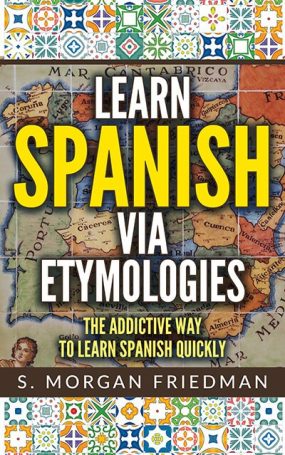Buscar and Postulate
- Posted by Morgan
- on Mar 27, 2024
- in True Spanish Etymology Stories
Buscar (Spanish for “to ask for”) comes from the Latin poscere (“to ask urgently”). In the transition from Latin to Spanish, the word was definitely weakened since buscar doesn’t have any urgent implication.
From this Latin root, we also get the English word… postulate. Postulating is really just formulating a thesis and wanting responses — which is just a sophisticated form of asking a question!
We can see the b-s-c of buscar maps to the p-s-t of postulate.
- See more of this pattern: True Spanish Etymology Stories
Cuero and Cork
- Posted by Morgan
- on Mar 26, 2024
- in True Spanish Etymology Stories
The Spanish for “leather,” cuero, comes from the Latin corium meaning, “leather or hide.” From that root, we get a few English words, including… cork. A cork is made from the the hide of a tree, after all!
From the same root we also get cortex (the tree that runs up your spine!), scrotum (feels like a skin, doesn’t it?)
We can see the c-r root clearly in all these words!
- See more of this pattern: True Spanish Etymology Stories
Pensar, Pesadilla and Pensive, Compensate
- Posted by Morgan
- on Mar 25, 2024
- in True Spanish Etymology Stories
The Latin pensare meant “to weigh”, in both senses: “to weigh something, such as gold, to get its value, usually to make a payment” or “to think about something deeply”.
From this word, we get a few Spanish words, including:
- Pensar – to “think”, just a simplification and lightening of the original.
- Pesadilla – with the diminutive -dilla ending added, it means “nightmare”. A dream is really just a small thought!
From the same Latin root, we get a few English words including:
- Pensive – with the same original meaning as the Latin.
- Compensate – which originally meant, “to counterbalance”, precisely what you do with a balance of justice!
- Pansy – which is basically an insult for someone who spends too much time thinking!
- Span – which originally meant to bind and came from the original sense of weighing.
- Poise – originally meant, “to have a certain weight,” which then came to mean “to have a certain look”.
The p-n-s root (sometimes without the ‘n’) is visible in all words.
- See more of this pattern: True Spanish Etymology Stories
Jerez – Sherry
 The Latin sounds for “sh” — and similar variations, like “ch” and “ss” — became a “j” sound in Spanish.
The Latin sounds for “sh” — and similar variations, like “ch” and “ss” — became a “j” sound in Spanish.
Thus, the English sherry is nearly identical to the Spanish jerez!
These sh/j sounds were often spelled with a “x” in old Spanish; and sherry itself is named after the town it first came from, Xeres, which is near Cordova.
Buitre and Vulture
- Posted by Morgan
- on Mar 25, 2024
- in True Spanish Etymology Stories
The Spanish buitre doesn’t obviously look like the English word it means: “vulture,” both of which are from the Latin vulturis.
But looking below the surface, we see the similarity: the b-t-r of buitre maps to the v-(l)-t-r of “vulture.”
This isn’t obvious at first for two reasons. First, the b- to v- transition: the sounds are identical in Spanish and often interchanged with each other, so it makes sense that they swap here.
But more subtly, the -l- between the vowels disappeared in the Spanish version, with the ulu becoming u-i. The vanishing of the -l- between the vowels is much more characteristic of Portuguese than Spanish (see almost every example in Portuguese, like comparing the Spanish vuelo with the Portuguese voo — an observation I first made in the Rio de Janeiro airport years ago!).
- See more of this pattern: True Spanish Etymology Stories
Coquetear and Cock
- Posted by Morgan
- on Mar 24, 2024
- in True Spanish Etymology Stories
Coquetear, the Spanish verb meaning “to flirt,” comes from the French coq which means “cock” — in both senses — from which we also get the English word cock, albeit with a slightly different spelling.
It’s not that hard to figure out how a word that means “penis” came to mean “flirt” — but it is easy to smile every time you remember why.
From the same root, we also get the almost-forgotten English word for “flirting,” coquetry.
The c-q to c-ck mapping is clear between both words.
- See more of this pattern: True Spanish Etymology Stories
what is the etymological way to learn spanish?
Nerds love to pattern-match, to find commonalities among everything. Our approach to learning languages revolves (the same -volve- that is in “volver”, to “return”) around connecting the Spanish words to the related English words via their common etymologies – to find the linguistic patterns, because these patterns become easy triggers to remember what words mean. Want to know more? Email us and ask:
morgan@westegg.com

